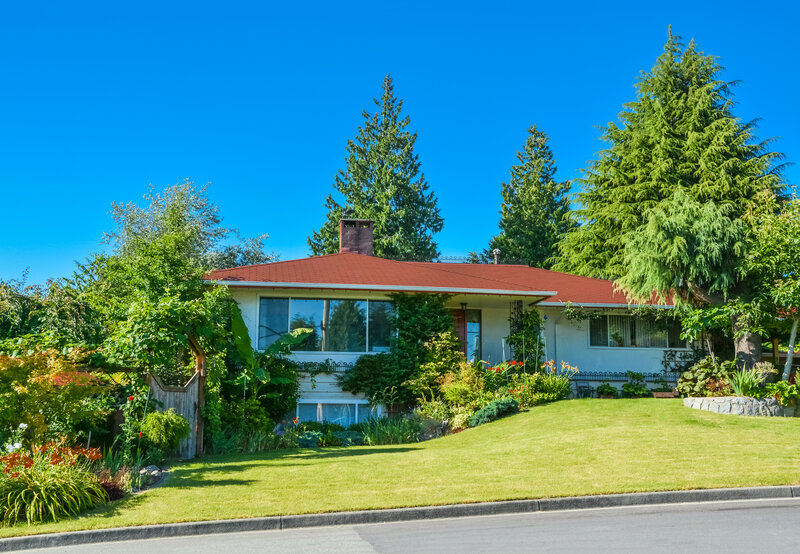
Your roof safety depends on various factors, ranging from its age and materials quality to your attention to roof maintenance and the property’s landscape design. The trees you plant and their proximity to a building’s roof have a tremendous impact on your roof’s health and longevity.
5 Ways To Protect Your Roof From Poor Landscape Choices
Landscaping for roof safety means paying attention to the types of trees you plant, as well as their proximity to the home, to prevent unnecessary roof damage. Here are five things you can do to protect your roof.
Schedule routine roof maintenance
One of the best ways to prioritize roof safety is to schedule annual roof maintenance with a licensed roofing contractor in your area. These yearly inspections are essential for noticing the red flags signaling repairs or replacement is needed or on the horizon. For example, during these inspections, we notice and can correct:
- Missing or damaged shingles, tiles, or other roofing components
- Algae or moss that lead to structural rot in a roof
- Excess tree debris indicating pruning or new tree selections would support roof health
- Damaged or corroded gutters and downspouts
During your roof maintenance reports, we can talk about landscaping for roof safety and make recommendations to support the lifetime of your roof.
Plant trees as if they’re already mature
Every tree has an estimated height, breadth, and canopy circumference at its most mature growth point. Unfortunately, most people plant for looks or shade but don’t take a long view. This leads to tree roots that destroy foundations or concrete patios and walkways. Misplaced trees also lead to avoidable roof damage due to dropped branches or excessive shade, creating ideal environments for mold, moss, and algae growth.
Before you plant a tree, speak with an arborist or local nursery expert about what you can expect in terms of the tree’s size and shape as well as its potential effect on your home’s roof. The experts’ knowledgeable recommendations will help you select trees that are better suited to your property and roof proximity.
Schedule annual or bi-annual tree pruning
Most people don’t prune their trees, which leads to excessive growth that does damage to a home’s roof and structure. However, roof safety isn’t the only risk there. Failing to prune trees puts the tree at risk for devastating broken limbs, disease of unhealthy branches and trunks, and overtaxed root systems that eventually give out.
Establish a relationship with a local tree pruning company and get on their regular schedule. In addition to promoting roof safety, your mature trees will look better, lusher, and healthier than ever before.
Consider planting deciduous trees
Yes, it’s true that deciduous trees are messier and lose their lush, green looks during the winter months. However, there is a benefit if your bare tree’s limbs extend over the roof. The less sun exposure your roof has, especially during the damper, wetter months, the more prone it is to growing roof algae or moss. These living organisms consume the organic materials (and some non-organic) in the roofing components, leading to leaks, decay, and eventual collapse.
By planting trees that shed their leaves in the winter, the roof stays dryer and has access to the sunshine in between storms, which makes it harder for algae or moss to take up residence for any length of time.
Protect your roof by replacing overgrown trees with better options
Have a tree that compromises your roof safety? We understand it can be painful, but it is probably worth having it removed. Homeowners insurance companies are getting increasingly strict about what they cover – or how much they’ll reimburse – if the roof or home damage seems preventable. So, having overgrown tree limbs that compromise the roof’s structure could diminish the amount the carrier has to pay out in the event of an accident.
If there’s a tree that is too large for the yard or whose older branches threaten the roof, it may be time to remove it and replace it with a species that’s better suited to the location.
Roof Safety Is A Priority At Central Bay Roofing
Have a question about your roof safety? Is your roof overdue for an inspection? Contact Central Bay Roofing and schedule an appointment. (510) 521-7334. Our team will evaluate the roof and make recommendations that support its health and longevity. We are also happy to recommend several reputable tree trimmers or arborists in the area who can help you make decisions about any landscaping threatening the safety of your roof.
Landscaping To Protect Your Roof: 5 Important Tips
Call Us On (510) 521-7334
Your Local Roofers Since 1978
We invite you to contact us today for an estimate on your roofing project.
1814 Clement Avenue Alameda, CA 94501
(510) 521-7334
info@centralbayroofing.comLicense: 435272 Class B, C-39
Site powered by RooferBoost
Copyright 2017 Central Bay Roofing and Restoration | Login
